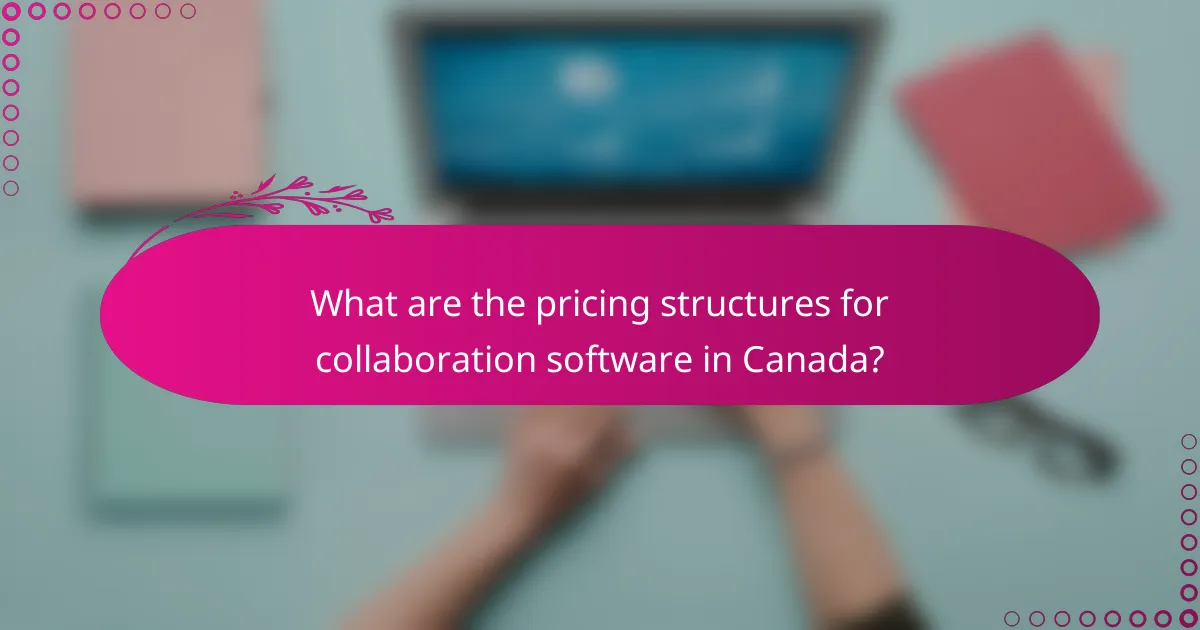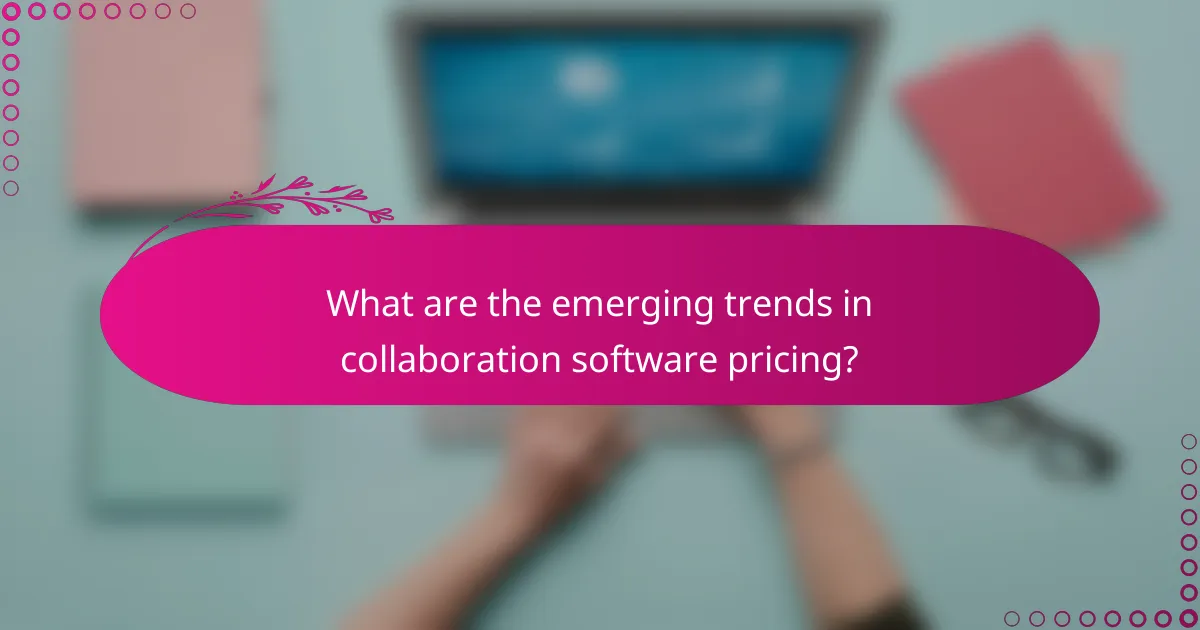Collaboration software in Canada offers a range of pricing structures, including monthly and annual subscriptions, freemium options, and tiered pricing based on features. User limits vary by plan, which is essential for accommodating different team sizes. Additionally, feature costs can differ significantly across platforms, making it important for organizations to evaluate their specific needs and budget when selecting the right tools.

What are the pricing structures for collaboration software in Canada?
Collaboration software in Canada typically offers various pricing structures to accommodate different user needs and budgets. Common models include monthly and annual subscriptions, freemium options, pay-as-you-go plans, and tiered pricing based on features.
Monthly subscription models
Monthly subscription models allow users to pay a set fee each month for access to collaboration software. This option is ideal for businesses that prefer flexibility, as it enables them to scale their usage up or down based on current needs. Prices can range from approximately CAD 10 to CAD 50 per user, depending on the features included.
When considering monthly subscriptions, be aware of potential price increases after promotional periods. Always review the terms to understand what features are included and if there are any additional costs for extra users or functionalities.
Annual subscription discounts
Annual subscription discounts offer a cost-effective solution for businesses willing to commit for a longer term. Many providers offer significant savings, often around 10% to 30% off the total cost compared to monthly payments. This can lead to substantial savings for larger teams.
Before opting for an annual plan, assess your organization’s long-term needs to ensure that the software will remain a good fit throughout the subscription period. Check for any refund policies in case you need to cancel early.
Freemium options available
Freemium options provide basic access to collaboration software at no cost, allowing users to explore features before committing financially. These plans typically include limited functionalities and user caps, making them suitable for small teams or individuals.
While freemium models can be a great way to test software, be cautious of the limitations. Upgrading to a paid plan may be necessary as your team grows or if you require advanced features, which can lead to unexpected costs.
Pay-as-you-go pricing
Pay-as-you-go pricing allows users to pay only for the features or services they utilize, making it a flexible option for businesses with fluctuating needs. This model can be beneficial for project-based work or seasonal demands.
However, it’s essential to monitor usage closely, as costs can accumulate quickly if not managed properly. Ensure you understand how usage is tracked and billed to avoid surprises on your invoice.
Tiered pricing based on features
Tiered pricing structures offer different levels of service at varying price points, allowing businesses to choose a plan that best fits their needs. Each tier typically includes a specific set of features, with higher tiers providing more advanced tools and functionalities.
When selecting a tier, consider both current and future needs. It may be more economical to choose a higher tier that includes essential features rather than paying for add-ons later. Review the feature lists carefully to ensure you select the most appropriate tier for your organization.

What are the user limits for popular collaboration software?
Popular collaboration software typically has user limits that vary by plan, affecting how many individuals can participate in a workspace or meeting. Understanding these limits is crucial for selecting the right tool for your team’s size and needs.
Slack user limits by plan
Slack offers different plans with varying user limits. The Free plan allows up to 10,000 messages to be searched and includes a limit of 15 integrations, while the Standard and Plus plans support unlimited users. The Enterprise Grid plan can accommodate large organizations with thousands of users across multiple workspaces.
Microsoft Teams user capacity
Microsoft Teams supports a maximum of 500,000 users in a single organization under its Enterprise plans. For meetings, up to 1,000 participants can join interactively, while live events can host up to 10,000 attendees, making it suitable for both small teams and large-scale webinars.
Zoom meeting participant limits
Zoom’s participant limits depend on the subscription tier. The Basic plan allows up to 100 participants per meeting, while Pro and Business plans can accommodate 300 and 500 participants, respectively. For large events, Zoom offers a Webinar plan that can host up to 10,000 attendees, depending on the package chosen.
Asana team size restrictions
Asana has no strict user limits for its Basic plan, allowing anyone to join a workspace. However, the Premium and Business plans are designed for teams and organizations, with features that become more beneficial as team size increases. For larger teams, it’s advisable to consider the Business plan to take full advantage of advanced features like timelines and reporting.

What are the feature costs associated with collaboration tools?
Feature costs for collaboration tools can vary significantly based on the platform and the specific functionalities required. Understanding these costs helps organizations choose the right tools that fit their budget and operational needs.
Cost of advanced features in Trello
Trello offers advanced features through its Business Class and Enterprise plans, which typically range from $10 to $20 per user per month when billed annually. These plans include features like advanced checklists, custom backgrounds, and priority support.
Organizations should evaluate whether the added functionalities, such as team boards and automation tools, justify the increased cost. For smaller teams, the free version may suffice, but larger teams often benefit from the enhanced capabilities of the paid plans.
Pricing for integrations in Monday.com
Monday.com provides a variety of integrations, but some are only available in higher-tier plans, which can cost between $8 and $16 per user per month. Integrations with popular tools like Slack, Google Drive, and Zoom are included in these plans, enhancing workflow efficiency.
When considering Monday.com, assess the necessity of these integrations for your team’s productivity. If your team relies heavily on specific tools, opting for a plan that includes these integrations may be more cost-effective in the long run.
Feature add-ons in Basecamp
Basecamp operates on a flat pricing model, charging a single fee of around $99 per month for unlimited users and projects. However, it does not offer many advanced feature add-ons, which can be a drawback for teams needing specialized tools.
Consider whether the simplicity of Basecamp’s pricing aligns with your team’s needs. If your projects require extensive features, you may need to look at other platforms that offer more customization through add-ons.
Custom solutions in ClickUp
ClickUp provides a flexible pricing structure with plans ranging from free to about $19 per user per month for advanced features. Custom solutions can be tailored to specific organizational needs, which may incur additional costs based on the complexity of the requirements.
When exploring ClickUp, it’s crucial to identify which features are essential for your workflow. Custom solutions can enhance productivity but may require a higher investment, so weigh the benefits against your budget constraints.

How do collaboration software pricing models compare?
Collaboration software pricing models vary significantly based on features, user limits, and subscription plans. Understanding these differences is crucial for selecting the right tool that meets your team’s needs and budget.
Comparison of Slack vs. Microsoft Teams pricing
Slack offers a free tier with limited features, while its paid plans range from approximately $6.67 to $12.50 per user per month, depending on the features required. Microsoft Teams, included with Microsoft 365 subscriptions, starts at around $5 per user per month for the basic plan, with more advanced features available in higher tiers.
When comparing Slack and Microsoft Teams, consider the user limits and integration capabilities. Slack’s free version allows up to 10 integrations and 5GB of storage, whereas Teams provides unlimited integrations but may require a paid plan for advanced features. Evaluate your team’s size and collaboration needs to choose the most cost-effective option.
Cost analysis of Zoom vs. Google Meet
Zoom’s pricing starts with a free plan that allows unlimited one-on-one meetings but limits group meetings to 40 minutes. Paid plans begin at around $149.90 per year per host, offering features like cloud recording and larger meeting capacities. Google Meet, part of Google Workspace, is included in plans starting at about $6 per user per month, with no time limits on meetings.
When deciding between Zoom and Google Meet, consider the specific features each platform offers. Zoom excels in webinar capabilities and breakout rooms, while Google Meet integrates seamlessly with other Google services. Assess your team’s requirements and budget to determine which platform provides the best value for your collaboration needs.

What factors should be considered when selecting collaboration software?
When selecting collaboration software, consider team size, specific feature requirements, and integration capabilities. These factors will significantly impact how effectively the software meets your team’s needs and enhances productivity.
Assessing team size and needs
Understanding your team size is crucial as many collaboration tools have user limits that affect pricing and functionality. For small teams, options with lower user caps may suffice, while larger organizations might require scalable solutions that accommodate hundreds or thousands of users.
Additionally, assess the specific needs of your team. For instance, if remote work is prevalent, prioritize tools that facilitate real-time communication and file sharing. Conducting a needs assessment can help identify essential features versus nice-to-have options.
Evaluating feature requirements
Different collaboration software offers varying features such as task management, video conferencing, and document sharing. Determine which features are critical for your workflow and compare them across different platforms to find the best fit.
For example, if your team relies heavily on project management, look for software that integrates task tracking with communication tools. Be aware that advanced features may come at a higher cost, so weigh the benefits against your budget.
Understanding integration capabilities
Integration with existing tools is essential for seamless workflow. Check if the collaboration software can connect with other applications your team uses, such as CRM systems or cloud storage services. This ensures that all tools work together efficiently, reducing the need for duplicate data entry.
Moreover, consider the ease of integration. Some platforms offer built-in integrations, while others may require additional setup or third-party services. Prioritize solutions that provide straightforward integration processes to minimize disruptions during implementation.

What are the emerging trends in collaboration software pricing?
Emerging trends in collaboration software pricing focus on flexibility, user-based models, and feature-based tiers. Many providers are shifting towards subscription models that allow businesses to scale according to their needs, while also offering a variety of features at different price points.
Flexible Pricing Models
Flexible pricing models are becoming increasingly popular, allowing organizations to pay only for what they use. This can include pay-per-user options or usage-based billing, which can be particularly beneficial for companies with fluctuating team sizes or project demands.
For example, some platforms offer a base fee for a core set of features and additional charges for premium functionalities. This approach enables businesses to customize their spending based on actual requirements, potentially saving costs in the long run.
User Limits and Tiered Pricing
User limits are a common feature in tiered pricing structures, where costs increase with the number of users. Typically, entry-level plans may accommodate a small team, while higher tiers support larger groups with more advanced features.
Organizations should assess their team size and growth projections when choosing a plan. For instance, a small startup might start with a basic plan for under $10 per user per month, while larger enterprises may need plans that cost $20 to $50 per user per month, depending on the features included.
Feature Costs and Value Assessment
The cost of features can vary significantly between different collaboration software options. Essential tools like chat and file sharing may be included in lower-tier plans, while advanced features such as integrations, analytics, and security enhancements often come at a premium.
When evaluating collaboration software, businesses should consider the value of each feature against its cost. A tool that offers robust project management capabilities might justify a higher price if it improves productivity and collaboration significantly.
